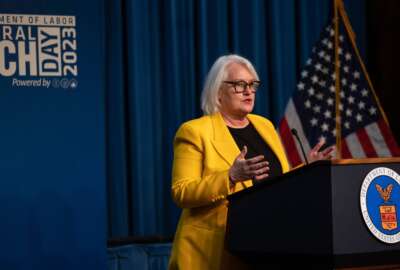The Transportation Security Administration wants its employees to think differently when it comes to innovating with technology. It’s not just cloud or mobility or any of the often-used buzzwords.
“One of the areas that we are seeing for innovation, particularly among agile and cloud, is it’s a culture shift. It’s a culture shift of the federal staff who have come up over the years to be either able to own and operate their systems or operate their systems with contractor support, and to be able to take that autonomy away and allow it to move into an environment where they may never see the system and all they see is the contract they may hold. It is changing the paradigm of what is information assurance from a government perspective. What does it mean to operate in a commercial environment?” said Stephen Rice, the TSA chief information officer, during a recent AFCEA conference. “The other aspect is our customers believe we are in the cloud already. They don’t ever go and see the boxes, go down to the data center. For them, it’s always on so they don’t really know where it’s operating. There is a level of expectation that is nebulous in the cloud environment now.”
Rice said there also is a culture change in the way his office has to communicate with the leadership to talk about the risk proposition of moving data and systems to the cloud. To that end, TSA established the office of the chief risk officer so they can help explain the risk to the agency and its current mission services, and how the IT systems support that effort.
“It’s a major shift in thought for the agency,” he said. “We are all looking at the same set of problems, though with a little bit different set of priorities. I’ve seen organizations without a cloud strategy, and these are multi-billion dollar organizations that are not moving to the cloud at all and have no intention. Their primary focus is on insider threat and their information holdings. The one thing that is of value about my role is I’m not trying to put people on the moon. I’m trying to provide efficiency to ensure the right information is in the right decision makers’ hands at the lowest cost possible.”
The lowest cost part is a huge focus area for TSA.
Congress has reduced TSA’s IT budget by $65 million over the last three years.
“We have been looking at the impact to recapitalization. We have a lot of fixed infrastructure and we are having to look at fiscal year 2017 and beyond about how can we be innovative so we don’t have to own those systems in the future and ultimately drive down the recapitalization costs,” Rice said after the panel in an interview with Federal News Radio. “It’s forcing conversations between us and the business owners on how they can be involved in making informed decisions on driving down their costs, but also increase the level of capability they have today.”
Rice said the budget cuts have forced delays to IT upgrades, and potentially is going to cost TSA more when they eventually do modernize systems and technologies.
But at the same time, he said the IT budget woes is an opportunity for innovation.
One area that is ripe for innovation is how TSA manages its data centers. Rice said over the last decade the agency’s development, it awarded contracts to run seven data centers.
He said in 2015 TSA expects to consolidate seven data centers because of a combination of expiring leases and contracts, and the consolidation of financial systems.
“Ultimately we have seven in flight simultaneously,” Rice said. “It’s allowing us to look at how do we become more efficient in managing the data, combining that data and also moving away from fixed infrastructure where we will have to push and have recapitalization costs either today or 3-to-5 years out, so let’s have those discussions now. It’s actually forcing us to be a lot more efficient.”
Rice said as part of the data center consolidation, TSA is reviewing the architecture of its systems and data and deciding whether to use one of the two DHS-wide data centers.
Rice added that beyond the data centers, TSA also has several back-office infrastructure support contracts expiring over the next two years.
He said this is helping TSA make risk and reward decisions around how to move forward with several of these functions, including whether to move to a public or government-only cloud.
“We are in the midst of developing our cloud strategy,” Rice said. “When you start looking at the development of the cloud strategy, you have to also understand what the full capabilities will look like. Do you want to move into an open source for application development as well as can you then set an expectation where you can develop applications much more agilely, but also being able to deliver more frequently so you go into a dev/ops type of approach, and what does that look like culturally, organizationally and what’s the outcome you are trying to drive to.”
RELATED STORIES:
TSA analyzes mobile needs before deployment
TSA ready to move on with ITIP contract
DHS defense FY 2016 cyber budget before Senate subcommittee
Copyright
© 2024 Federal News Network. All rights reserved. This website is not intended for users located within the European Economic Area.






